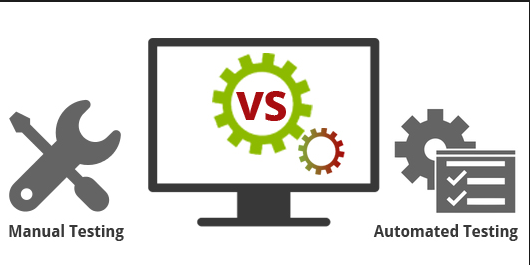Manual testing is still the most time-consuming and wasteful process of creating any software product. Nevertheless, permanent development of technologies and computer systems allows reducing the number of testers.
This makes us ask: is manual testing dying, has this job a future, won’t it become a trivial relic of the past?

Manual Testing
QA Job Is Not New
Somehow everyone thinks that testing is a new job which appeared in the middle of the 1990s. But it is not true.
Honestly speaking, the process of manual testing, checking the operability of software product was still known at the beginning of the technological age.
In the middle of the 20th century, whole cybernetic corporations and scientific institutes were performing manual testing.
And the group of automated tools, which allows simplifying the process of testing, appeared in the 1980s.
Right this moment can be regarded as a turning point for a community of manual testing. Whereas previously it was performed only by highly specialized employees of scientific centers and unities, after the appearance of software testing, even less qualified employees can try themselves in this process.

QA Job Is Not New
Growing Number of “Clickers”
Growing interest in the job of a manual tester was influenced by 2 factors at once:
- Growing number of software released;
- An increase of complexity of software visual interface;
- Global orientation on system products.
Right these reasons caused a situation when products and system components started to be produced for an average user without special knowledge and education. The simple tester had to be familiar with the product, have skills of using the visual interface and also know the rules of consistency of the reports defined.
Long-term cooperation of tester and developer allowed quite efficiently find all imperfections and in the system product and also release completely working and tested programs and components.
Manual testing became extremely important in the period of fast growth of computer games released which needed thorough monitoring of the proper functioning of every computer component.
But, however trivial it may sound, the progress never stops and permanent improvement of the programs and systems allows quickly and efficiently automate any process relates to computer technologies which were previously performed by the tester manually. This helps to cut the costs of the client and save time, so the final product becomes cheaper.
As a result, just in a few years, the sphere of activity of manual tester has become much more limited. But, at the same time, requirements for him or her became stricter.
And there are more and more thoughts that probably manual testing is not in fashion and will probably just “die”. That’s why we don’t need to study manual testing.
But is it really true?

Manual Testing vs Automated Testing
Not Only Automation
You can be absolutely confident that in the nearest future it will be impossible to create the software component which can perfectly simulate the system of human perception and certainly the peculiarities of the mental state.
It means that the product produced for a human must be tested only by a human. To a greater extent, this applies to a visual interface of the product – shifted blocks and elements, problems with correct displaying of media files, etc. will be for a long time controlled only by the tester.
Nowadays there is no possibility to fully and efficiently automate such original process as usability of programs or components. To a greater extent, this applies to game products and applications which have a lot of animation and visual details.
Next Stage of Development
So it can be said that the job of a manual tester is not “dying” but reached the next level of professional development.
During the last 30 years, testing was performed by experts who perfectly know their products.
In the next 5-10 years, the situation won’t change, as the manual tester will stay the same expert and specialist.
It means that right now you need to permanently improve your skills and knowledge.

Next Stage of Development
Transformation of Approaches to Manual Testing
Having studied numerous approaches in the testing field and conducted pilot processes, we can define some key approaches and techniques, which nowadays form a holistic example of progressive manual testing:
- Using unit tests and integration techniques – it’s the most important base of interoperability with program code. Every QA must add automated tests to features;
- Permanent integration – a framework where all created automated tests are performed even during editing the program code. Nowadays the field has numerous similar solutions for such type of automation and the most popular of them are: Travis CI, Jenkins, Circleci;
Using all mentioned techniques and technologies, you can greatly reduce the technical duty and optimize the process of development, that, in turn, will help to minimize searching of bugs and failures when manually testing the created product.
So Can We Completely Do Without Manual Testers?
With the help of a proper technological approach (as mentioned in the previous paragraph), the role of manual testing is greatly diminishing.
And in this case, so-called TestFest appears – a new approach of manual testing where the process of testing the product is performed directly before the final releases. This work must include product managers, engineers, sometimes UI/UX designers, QA team, of course, and sometimes some representative of the clients.
In short, it can be said that such a team becomes the manual testers for some hours. And this, by the way, is really efficient!
The result of TestFest is a huge list of bugs and weaknesses and each of them gets a special status of importance and is directed to the mutual scope.
Right this method can be seen as the right method to develop the department of manual testing and its future growth.
What Conclusions Can Be Made?
Don’t leave manual testing! Always improve it.
When transforming the business processes, never forget about quality assurance.
Efficiently use methods and approaches available in the network, contact software testing companies and you will immediately notice that the number of bugs and errors will greatly decrease, the same as the amount of work for your testers. Try not to use “part-time” philosophy which prevented QA to fully interoperate with the program components and to reach positive results in the work.
It’s logical to suppose that development and improvement of the testing field will positively influence the work of developers who will change their philosophy of creating the future products with the help of changing the approach to work.
Certainly, there are products and even whole systems with a huge number of errors and it does not depend on approach to testing. But generally, it looks like that only complete transformation of manual testing can help to develop the QA field and increase the quality of the product.
And finally, any type of testing needs to use such a thing that is between our ears. There are not such disparate terms as manual and automated testing. There are just testing, checking, finding bugs – a special type of human work which can be done only by humans, not robots.










Leave A Comment